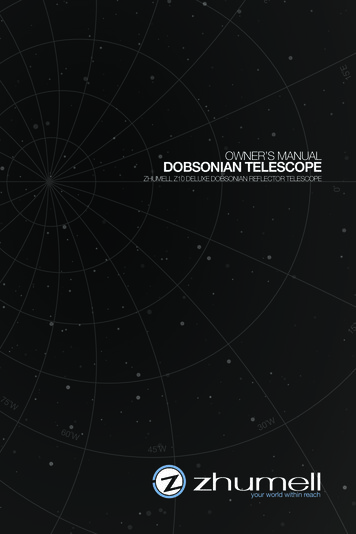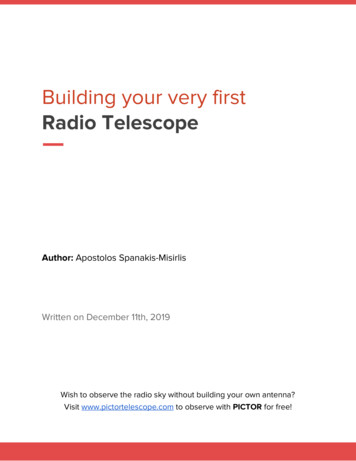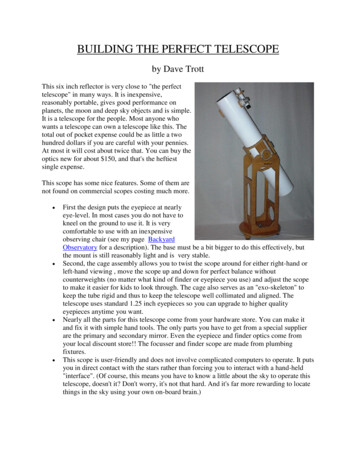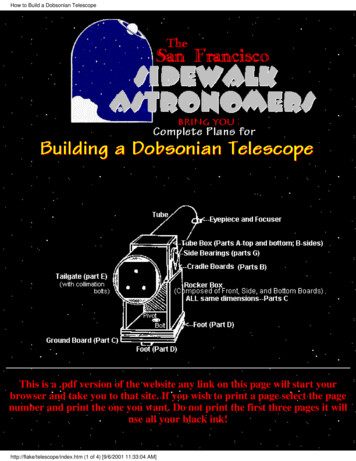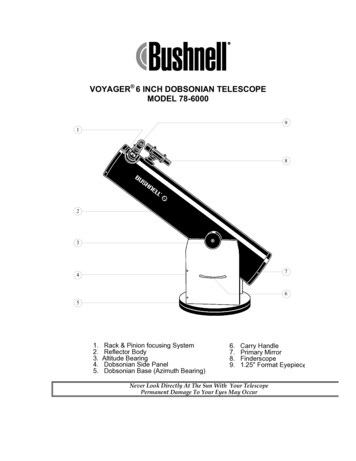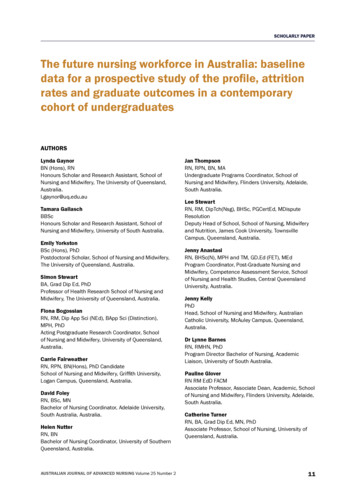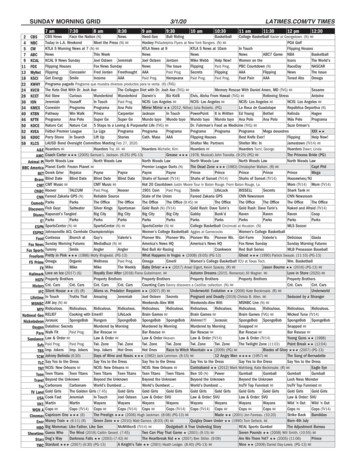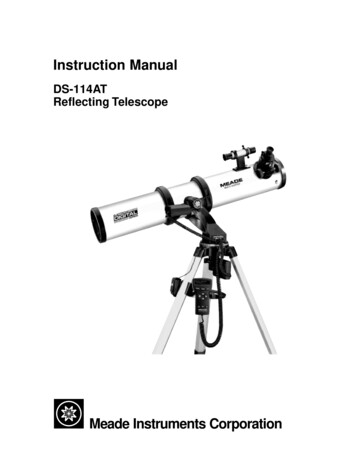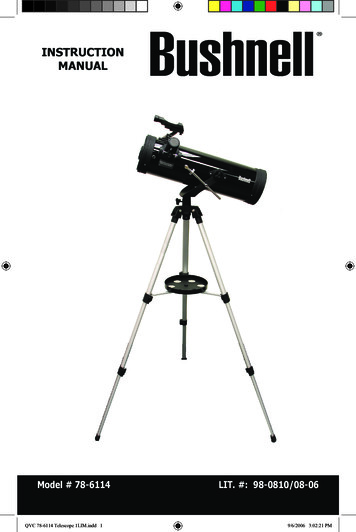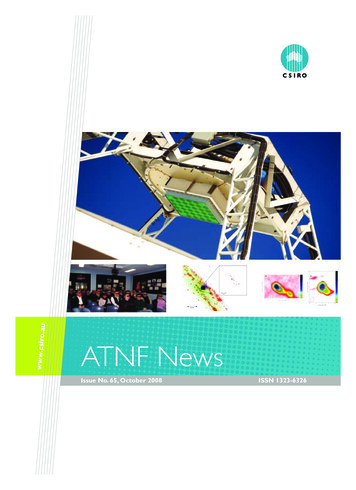
Transcription
ATNF NewsIssue No. 65, October 2008ISSN 1323-6326
ATNF outreachRob Hollow (ATNF)PULSE@Parkes projectThe PULsar Student Exploration onlineat Parkes (PULSE@Parkes) project isnow up and running successfully on aregular basis. We host one high schoolper month at Marsfield for studentobservations. Schools receive a preobserving visit by a project staff memberto learn about radio astronomy, pulsarsand what an observation sessioninvolves. A successful demonstrationsession involving 15 students fromthree Perth schools was held at theSPICE Centre at the University ofWestern Australia in March 2008.Talks about the program were presentedat the American Astronomical Society/Astronomical Society of the Pacific JointMeeting in St Louis in the USA in June2008, as well as the Astronomical Societyof Australia annual meeting in Perth, thenational science teachers’ conference,CONASTA, in Queensland in July2008 and the NSW Science Teachers’Conference in late November 2008.Students from Caroline Chisholm College observing for thePULSE@Parkes project.Photos: Robert Hollow, CSIROATNF’s Education Officer, RobHollow visited the University ofTexas, Brownsville in June as part ofthe project collaboration. He spent aweek at their Summer School for HighSchool Students presenting severalsessions and learning more aboutthe programs run there including theArecibo Remote Control Centre.For more information visit theproject webpage: kes/Cover page imagesPhoto: David McClenaghan, CSIRO (See page 9)Photo: Carole Jackson, CSIRO (See page 9)Image: Emil Lenc, CSIRO and Steven Tingay, Curtin University of Technology(See page 23)Image: Richard Dodson, University of Western Australia (See page 26)2 ATNF News , Issue 65, October 2008
ContentsATNF outreach. 2From the Director. 4Dr John Paul Wild AC CBE MA ScD (Cantab.) FRS FTSE FAA17 May 1923 – 10 May 2008. 5Parkes achieves world-beating pulsar timing precision. 6ASKAP update. 9New Postdoctoral Fellows and Research Scientist. 12ATNF Graduate Student Program. 13ATNF distinguished visitors. 148th ATNF Synthesis Imaging School. 14Twenty years of the Compact Array. 16Memorandum of Understanding (MOU). 19The scattered debris of the Magellanic Stream. 20The nuclear region of NGC 4945 revealed. 23Polarisation observations with the LBA. 26ATNF Operations. 28ATNF Science Operations. 29Time assignment information. 30ATNF Engineering Operations. 31ATNF publications list. 32ATNF outreach. 38EditorialRegular readers of the ATNF News willnot have failed to notice that this is thefirst issue in our new format, with theadoption of a standardised CSIRO formatfor the design and layout. This year alsomarks a change from three to two issuesa year, nominally in April and October.This issue contains an obituary for DrPaul Wild, who passed away in May2008. Paul Wild was instrumental inthe design and establishment of theCulgoora Solar Radio Observatory in the1960’s, served as Chief of the Divisionof Radiophysics in the 1970’s, and wasChairman of CSIRO from 1978 to 1985.The Culgoora Observatory is now hometo the Australia Telescope CompactArray (ATCA), and elsewhere in thisissue Helen Sim looks back over 20 yearsof the ATCA and identifies a number ofits strengths and successes. One of thestrengths is the solid grounding studentsreceive in observing with the ATCA,and Phil Edwards reports on the 8thSynthesis Imaging School at the ATCA .A report on the Parkes Pulsar TimingArray, and articles describing studiesof the Magellanic Stream, the starburstgalaxy NGC 4945, and polarisationobservations with the Long BaselineArray, illustrate the breadth ofscience being undertaken with ATNFfacilities. The recent changes to thestructure for managing telescopeoperations are outlined, and ongoingplanning for future operations,incorporating ASKAP, are presented.This issue is the last with Mary Mulcahy atthe helm as Mary will move on to a newposition in another division of CSIROin the new year. We thank Mary for herenthusiasm and attention to detail in herrole as ATNF Communications Manager.Mary Mulcahy and Jo HouldsworthThe ATNF Newsletter Production Team(newsletter@atnf.csiro.au)News 3
NEWSFrom the DirectorBrian BoyleCSIRO ATNF DirectorAs I write this I am struckby a tremendous sense ofwhat has been achieved inAustralian radio astronomyduring 2008 by ATNF andCSIRO more broadly, togetherwith our many partners.The list of specific milestones thatcome to mind includes the following: During the first half of the year therewas a specific focus on proactivelyengaging with the ATNF usercommunity to discuss the plansfor changes to ATNF operations.The need for change is undeniablegiven the commitment to operatinga new world-class observatory, theAustralian Square Kilometre ArrayPathfinder (ASKAP), in a few yearstime in an environment where costsare growing faster than recurrentfunding. The engagement with thecommunity involved significant effortfrom a number of senior ATNF staff,including roadshows to most majorcities in Australia to engage withour user base to discuss plannedoperational changes, the developmentof a set of Science Priorities for theATNF telescopes for the 2010–2015period, the development of the UserPolicy for ASKAP, and the call forExpressions of Interest for the majorSurvey Science Projects for ASKAP.Together these efforts have beenvery positive in securing a strong andhealthy engagement between ATNFand the astronomy community. Theresponse to the call for Expressionsof Interest in ASKAP survey sciencehas provided an outstandingdemonstration of the vibrancy of theinternational astronomy community,4 ATNF News , Issue 65, October 2008and of the potential for ASKAP todeliver groundbreaking science. Thirtyeight expressions of interest havebeen received, from a total of 608investigators (354 independent) basedin 23 countries. Over the comingweeks these will be assessed, and theninvitations will be extended to groupsto develop full proposals. Given thatit is likely that there will be just fiveor so ASKAP survey science projectsover the first five years of operation,this degree of interest at this earlystage augurs well for great science. From 1 July 2008 the organisation ofATNF Operations changed from astrong observatory alignment to a“Science Operations” and “EngineeringOperations” structure that extendsacross all ATNF observatories, andwhich will include ASKAP oncescientific operations begin in 2012. Thenew structure is already resulting in apositive sharing of knowledge acrossthe wide range of ATNF activities.The transition from leadership by ourexcellent Officers in Charge, JohnReynolds (Parkes) and Phil Edwards(Narrabri) to the Head of EngineeringOperations, Brett Dawson, and ofScience Operations, Phil Edwards,has been effected seamlessly. In August the ASKAP team achievedfirst light with the chequerboardPhased Array Feed designed byJohn O’Sullivan on the newlycommissioned 12-m testbed antennaat Parkes. The results were andcontinue to be very encouraging, witha remarkable degree of agreementbetween the measured and predictedperformance which underlines theteam’s deep understanding of thephysics of these systems. Whilethere are still many challenges tobe solved with these systems theresults achieved to date are verypromising and indicate the retirementof some of the greatest technicalrisk involved in the ASKAP project. The signing of the ASKAP antennacontract with CETC54 was anothermajor milestone for the year. CETC54will deliver thirty six 12-m antennas,including an innovative third rotationaxis judged necessary to achieve thevery high dynamic range target forASKAP, for under A 10M meeting acost target considered by many to bea major commercial challenge for theproject, and even for the SKA itself. More broadly, the Australian SKAIndustry Cluster has played a key rolein furthering industry participationin the ASKAP project. A numberof strategic partnerships havebeen forged, and the release of theIndustry Opportunities Register inOctober was a significant highlight. The approval on 3 December inthe Australian Federal Parliamentof the expediency motion for theconstruction of ASKAP followingthe completion of its considerationby the Parliamentary StandingCommittee for Public Works (PWC)amounts to the “green light” forthe start of construction. The PWCsubmission involved a great deal ofeffort across CSIRO, with supportfrom the Commowealth and WAState governments. It stands as atestament to the ability of CSIROto undertake large, unique, capitalintensive scientific developments inAustralia. Moreover, it serves as anappropriate conclusion to a highlysuccessful year for “Team Australia”which began with the highly successfulinternational SKA Forum in Perth.
Dr John Paul Wild AC CBE MA ScD (Cantab.)FRS FTSE FAA 17 May 1923 – 10 May 2008Geoff Garrett, CSIRO Chief Executive The continued successful developmentand testing of the Compact ArrayBroadband Backend (CABB)correlator during 2008 has been verypleasing. Recent months have beenregularly punctuated by reports ofthe progressive solution of technicalchallenges, and of successful tests ofan increasingly capable system. Onceoperational, CABB will revolutionisethe scientific capability of the CompactArray and maintain its competitivenessin the Expanded Very Large Array(EVLA) and the Atacama LargeMillimeter Array Project (ALMA) era.The fact that these milestones, havebeen achieved while continuing tooperate three very complex scientificobservatories 24 hours a day, 7 days aweek, facilitating the remarkable scientificdiscoveries outlined in this newsletterand detailed elsewhere, is a tributeto the efforts of all the staff involvedwithin ATNF and elsewhere in CSIRO.The scientific productivity of the ATNF’stelescopes remains outstanding, andthe articles in this Newsletter give ataste of the quality of the science thatcontinues to be delivered through theexpertise of the users of the ATNF.Finally I’d like to welcome all the newappointees to the ATNF, some ofwhom are featured in this newsletter.The ATNF has an outstanding poolof talent in its staff and its greateststrength derives from the knowledgeand dedication of those people, bethey engineers, scientists, techniciansor experts in some other area thatis integral to achieving CSIRO’s goalsin the field of radio astronomy.Best wishes to everyone at theend of 2008, and here’s to ahappy and prosperous 2009.CSIRO deeply regrets thepassing of Dr John PaulWild, distinguished scientistand former Chairman ofCSIRO. Dr Wild died onSaturday, 10 May 2008.Dr Wild was one of Australia’smost respected and inspirationalscientist and engineers.Dr Wild was best known for hiscontributions to Solar Science. He waspart of the team that built and operatedthe original solar radiospectrographs andlater the Radioheliograph at Culgoorain NSW. The Radioheliograph was aground breaking instrument producingreal time images of solar activity acrossa range of altitudes from the sun’ssurface. In the late 1960’s and early‘70’s the Culgoora group led the worldin solar research attracting prominentsolar physicists from around the world.Dr Wild successfully applied hisconsiderable initiative and expertiseto the development of groundbreaking technology for industryand the community. As Chief of theCSIRO Division of Radiophysics from1971 until 1978 he led the teamthat developed the Interscan aircraftlanding system that was adopted in1978 as the international standard.Colleagues appreciated his generosityin sharing ideas. He was extremelyapproachable and had the magical abilityto reduce the most complex of conceptsto simple terms understood by all. Hiscolleagues appreciated the fact thatwhen these concepts were realised inpractice he never failed to acknowledgethe role they played in developing them.Dr John Paul WildPhoto: CSIROAs Chairman of CSIRO from 1978 to1985, Dr Wild was a national scienceleader. He led the Organisation throughthe restructure designed in 1978 tomodernise the Organisation and bring itcloser to the industries and communitywhich it serves. He recognised thatCSIRO needed to adapt and providescientific and technological leadershipin a changing world. And, as he wrotein 1984 “Yet, whatever the changes, onecharacteristic must remain inviolate: ahigh standard of excellence and originality.Without excellence and originality,research achieves nothing.” During thisperiod he was instrumental in securingfunding for major national researchfacilities including the oceanographicresearch vessel, the Australian AnimalHealth Laboratory and the AustraliaTelescope, and he established a newDivision of Information Technology.He has left a rich inheritancewhich will continue to bringenormous benefits to Australia.On behalf of his colleagues andfriends at CSIRO, I would like toextend our condolences and bestwishes to his family and friends.News 5
Parkes achieves world-beating pulsar timing precisionDick Manchester (ATNF)The Parkes radio telescope has a well-founded reputation for pulsarastronomy, with about two-thirds of the approximately1800 knownpulsars having been discovered there. While discovering pulsarsis important, the most significant science comes from the followup studies, especially pulse timing observations. Now Parkes canlay claim to achieving world-beating pulsar timing precision usingthe Pulsar Digital Filterbank (PDFB) systems developed at ATNF.Pulsars are remarkable objects, tinyspinning neutron stars formed insupernova explosions at the death ofmassive stars. They have super-strongmagnetic fields and the combination ofthis with very rapid rotation – the fastestknown pulsar spins 716 times everysecond – means that pulsars are highlyefficient dynamos, generating enormouselectric fields in the “magnetosphere”surrounding the neutron star. Theseelectric fields accelerate charged particlesto ultra-relativistic energies resultingin the emission of powerful beams ofFigure 1: Greyscale plot of intensity of PSR J0437-4715 as a function of pulse phaseand frequency. The one-hour observation was made on 6 September 2008 using the10-cm receiver with a total bandwidth of 1024 MHz and PDFB2 in folding mode. Theplot is of the raw spectral data and has been clipped at 20% of the peak to bettershow the low-level structure.6 ATNF News , Issue 65, October 2008radiation. These beams sweep acrossthe sky as the star spins, generating aperiodic train of pulses for any observerin their path. Because of the hugemoment of inertia and small radius ofa neutron star, the pulse periodicityis extraordinarily stable, makingpulsars marvellous celestial clocks.Timing of pulsars has many applicationsranging from studies of neutron-starinteriors to testing of theories ofgravitation. Pulsar timing can also beused to establish a so-called “pulsartime” and to check for irregularities inthe international timescales based onatomic clocks. Although pulsar timingobservations were made over manyyears at Parkes using the analoguefilterbank systems used for pulsarsearches, precision pulsar timing reallybegan in 1993 with the Fast Pulsar TimingMachine, a collaborative effort betweenCaltech and ATNF. Since then, severalgenerations of baseband recordingsystems giving increasing timing precisionhave been developed in collaborationwith Swinburne University of Technologyand used, especially for pulsar astrometryand the study of binary pulsars. In 2003,the Parkes Pulsar Timing Array (PPTA)project was established with the principalgoal of making a direct detection ofgravitational waves using pulsar timing.To have a chance of reaching thisambitious goal, regular observationsof at least twenty millisecond pulsarsover 5 – 10 years with unprecedentedtiming precision are required.In order to reduce the perturbing effectsof propagation through the interstellarmedium, observations at relatively highradio frequencies are best for precision
pulsar timing. But pulsars, especiallymillisecond pulsars, are relatively weakand steep-spectrum radio sources, sowide bandwidths are required to givethe necessary sensitivity and radiofrequencies of a few GHz are optimal.The 10/50-cm receiver was designedwith these ideas in mind, with the10-cm system having a bandwidth of 1GHz between 2.6 and 3.6 GHz. Suchbandwidths place severe demandson the signal processing system.The PDFB system was designed to meetthis challenge. It has 8-bit digitisationof either two or four input signals anda maximum bandwidth of 1024 MHz.A polyphase filterbank is used to spliteach input signal into a maximum of2048 frequency channels. Channeloutputs are correlated to give fourpolarisation products per channel. Theseare then synchronously folded at theapparent pulsar period and integratedin a pulsar binning memory with amaximum of 2048 bins per period.These maximum specifications can bereached for pulsars with periods offour milliseconds or more. The systemis based on the signal processor boarddeveloped for the Compact ArrayBroadband Backend (CABB) systemwhich contains 10 high-performanceField Programmable Gate Array (FPGA)chips and a large amount of memory.The PDFBs have several modes ofoperation. Normally they are used withtwo inputs to produce full-polarisationpulse profiles in each channel acrossthe band. Figure 1 shows a typicalobservation of the strong southernmillisecond pulsar, PSR J0437-4715,illustrating the high time and frequencyresolution of the observations. They canalso operate in “search” mode wheredata from each frequency channelis integrated for a time, typically 100microseconds, and then dumped todisk, and in spectral-line mode whichis similar except that integration timesare typically longer. For fold-mode andsearch-mode data, files are written inPSRFITS format, whereas spectral-modefiles use RPFITS format. The PDFB systemcan also operate as a front-end for thenext-generation baseband system, ATNFParkes Swinburne Recorder (APSR),currently being developed in conjunctionwith Swinburne University of Technology.A system for real-time mitigation ofradio frequency interference (RFI) usingadaptive filtering is also provided.To determine pulse times-of-arrival(TOAs), the calibrated total intensitypulse profiles are correlated with astandard profile template giving thephase of a reference point on thetemplate relative to the start time ofeach observation. These TOAs are thencorrected for offsets in the Parkes timesystem and for delays due to interstellardispersion. These are then referred tosolar-system barycentre, correctingfor both the propagation time andthe change in gravitational potential,giving infinite-frequency TOAs in whatFigure 2: TEMPO2 plot of post-fit timing residuals over one year for 10-cmobservations of PSR J0437-4715 using PDFB2. There are a total of 147 TOAs, eachfrom a 1-hour observation, and a total of 10 model parameters were fitted for.News 7
is assumed to be an inertial referenceframe. These TOAs are then comparedwith predicted TOAs based on a modelfor the pulsar, including its position,proper motion, pulse frequency andits derivatives and binary parametersif appropriate. The difference betweenthe observed and predicted TOAs areknown as timing “residuals” and are thebasic product of pulsar timing. Systematicvariations in these residuals can be usedto improve the parameters of the pulsarmodel and to search for un-modelledeffects such as relativistic perturbationsin binary parameters or pulse frequencyperturbations due to gravitational wavespassing over the pulsar or the Earth.To make a significant detection of thestochastic gravitational-wave backgroundin the Galaxy, we need to have rootmean-square (rms) timing residuals oforder 100 nanoseconds for most ofour sample. This is a very demandingrequirement which has not even beenapproached in previous pulsar timingobservations. However with the PDFBsystems we are approaching this levelof precision. Figure 2 shows our bestresult to date, an unprecedented 56nanosecond rms timing residual overone year for PSR J0437-4715 usingthe 10-cm receiver and PDFB2. Dataprocessing made use of the PSRCHIVEand TEMPO2 software systems.While our current results constitute themost accurate pulsar timing results everobtained for such a large pulsar sample,they are not yet sufficiently preciseto detect the predicted gravitationalwave background in the Galaxy. Weare continuing to work on removal ofsystematic errors in the data and onimproving our processing algorithms.We have also established collaborationswith the European and North Americanpulsar timing array projects (EPTA andNANOGrav, respectively) to form8 ATNF News , Issue 65, October 2008Figure 3: Commissioning of the five export PDFBs at Parkes on 13 October 2008.From left, the people are Hongfei Liu (National Astronomical Observatories, ChineseAcademy of Sciences (NAOC), Beijing), Zhiyong Liu (NAOC, Urumqi Observatory),Tim Ikin (Jodrell Bank Centre for Astrophysics, University of Manchester), MaozhengChen (NAOC, Urumqi Observatory), Dick Manchester (ATNF), Andrew Brown(ATNF), George Hobbs (ATNF) and Warwick Wilson (ATNF).Photo: John Sarkissian, CSIROthe International Pulsar Timing Array(IPTA). The increased sky coverageand number of observations affordedby the IPTA will considerably enhancethe chances of a successful detectionof gravitational waves. Looking furtherinto the future, the enormous sensitivityof the Square Kilometre Array willallow observations of a much largersample of pulsars, making possible notonly detection of gravitational waves,but detailed study of both the wavesand the sources that emit them.The outstanding performance of thePDFB systems is a tribute to the ATNFengineers and scientists who designedand constructed them. As an illustrationof the impact of the developmentof these systems, the ATNF has justcompleted construction and testing offive systems under contract to otherobservatories around the world, threein Europe and two in China. Beforeshipment, these systems were all testedat Parkes. Figure 3 shows five systemsin the Parkes tower with the teamof ATNF and visiting engineers andscientists involved in the commissioning.The design and construction of thePDFB systems was led by ATNFengineers Grant Hampson, AndrewBrown and Warwick Wilson, with majorcontributions from John Reynolds,Evan Davis, Paul Roberts, MichaelKesteven and Mark Calabretta.
ASKAP UpdateDiana Londish (ATNF)CommonwealthParliamentaryStanding Committeeon Public WorksThe Commonwealth ParliamentaryStanding Committee on Public Worksis tasked with reviewing proposedexpenditure of public money, andpreparing and presenting reports andrecommendations for Parliament.Documentation on the Australian SquareKilometre Array Pathfinder (ASKAP) wassubmitted by CSIRO to the committeein June 2008 and the in camera andpublic hearings took place on 1 Octoberin Geraldton. The Committee’s reportwas tabled in the CommonwealthParliament on 1 December, expressingsupport for the ASKAP project as partof the continued development of radioastronomy in Australia. The motion wasapproved by Parliament on 3 December.ASKAP ScienceAn ASKAP User Policy Taskforce hasbeen set up to determine accesspolicies for both large surveys and smallgeneral science experiments. Issuesdealt with include user support, openaccess policies, and the interaction withthe international Virtual Observatorycommunity. A workshop to discusssynergies between proposed ASKAPsurveys and planned optical andinfrared surveys was held in Melbournefrom 24 – 26 September, hosted bySwinburne University of Technology.A call for Expressions of Interest(EoI) to be involved in designing andimplementing an initial set of SurveyScience Projects for ASKAP was issuedon 1 November, with submissiondeadline 15 December. This has resultedAbove: The 5x4 chequerboard-designphased array feeds installed at the focusof the Parkes Testbed Facility antenna.Below: ASKAP team members enjoy a3-D show of the antenna build process.(See also front cover.)Photo: David McClenaghan, CSIROPhoto: Carole Jackson, CSIROin 38 submissions from PrincipalInvestigators in10 different countries.Wide-field Array (MWA) project andthe old MWA caravan was removed.Other upgrades and activities includedplacement of a portable generator fortemporary additional power, upgradingof air-conditioners on the MWAhut, dressing of cables to MWA tiles,installation of additional receivers in theMWA hut to support more tiles (up to32), installation of beamformers, testingof the 8-tile (8T) system and generaldata collection. By the end of November,26 MWA tiles were operational, andInformation relating to ASKAP science,call for EoIs and User Policy can befound on the ASKAP web pages athttp://www.atnf.csiro.au/projects/askap/MROAt the end of September a newtemporary hut was deployed on siteat the Murchison Radio-astronomyObservatory (MRO) for the MurchisonNews 9
the remaining six tiles will be broughton line in January. Following theinstallation of the system test scienceobservations were made of the Sun,and the data were processed at CurtinUniversity of Technology in Perth.RQZFurther protection for the MROradio-quiet zone (RQZ) was put intoplace during 2008 with the WesternAustralian (WA) government adoptingthe technical standards and assessmentprocedures recommended by CSIRO tomanage its declared Mineral ResourceManagement Area (MRMA) under theWA Mining Act. The conditions requirethe licensee or lessee of all new miningleases and licences within 80 km of thecentre of the MRO to submit a plan ofactivities to the WA Government forapproval. A duly approved Radio QuietManagement Plan must henceforthbe included with any Program ofWork or mining proposal submitted togovernment, for those mining activitiesthat fall within the MRMA zone.Antenna tenderThe ASKAP antenna Request forTender (RFT) closed in May 2008and a tender evaluation process wasrun to the plan set out in the TenderHeader Document, with visits beingmade to shortlisted tenderers.On 3 November CSIRO announced thatthe major contract for the antennas wasawarded to the 54th Research Instituteof China Electronics Technology GroupCorporation (known as CETC54).CETC54 will supply thirty-six 12-mantennas for under A 10 million, meetinga key cost target of under 300,000per delivered antenna. A critical design10 ATNF News , Issue 65, October 2008review (CDR) was held 17-19 December,in China at CETC54’s premises.Parkes Testbed FacilityThe ASKAP project has developed theParkes Testbed Facility (PTF) based ona 12-m diameter prime focus antennabuilt by Patriot Antenna Systemsat Parkes Observatory. Its purposeis to test the CSIRO-developedphased array feeds (PAF). The Parkes64-m dish provides a platform fordeeper, more sensitive testing ofthe PAF in tandem with the PTF.elements of the PAF, a major step indemonstrating that the array performsas expected. The PAF was returnedto Marsfield in late November forrefitting with upgraded components.Digital signalprocessing/ComputingThe architecture for the digital systemhas been completed, and the teamis developing the details and path todelivery. The Concept Design Review iscompleted, and the Preliminary DesignReview was held on 5 December.The PTF pedestal houses an ASKAPstyle beamformer, antenna controland monitoring systems. In additiona trial forced-air ventilation systemwas installed, providing cooling tothese sensitive components.The ASKAP project is preparing a callfor Expressions of Interest to collaborateon the development of a single digitalbackend with the ASKAP project; this willbe opened on AusTender in early 2009.In mid-May a group of 30 ASKAP teammembers travelled to Parkes to viewthe PTF and plan for the PAF tests.Industry Engagementramps up for ASKAPAs well as being able to checkout the antenna and the facilitiesinstalled at Parkes to support thePTF (including a new RFI-screenedroom in the woolshed), the teamenjoyed the 3-D show of the antennabuild process and a “hay ride” onthe 64-m dish capped off the day.Phil Crosby and Carole Jackson (ATNF)A major milestone was reached on24 July when the first prototype PAFwas hoisted onto the antenna, andtesting began the following Sunday. OnTuesday 29 July the team capturedsignals
Western Australia in March 2008. Talks about the program were presented at the American Astronomical Society/ Astronomical Society of the Pacific Joint Meeting in St Louis in the USA in June 2008, as well as the Astronomical Society of Australia annual meeting in Perth, the national science teachers' conference, CONASTA, in Queensland in July
